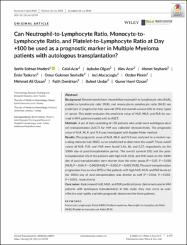| dc.contributor.author | Solmaz Medeni, Şerife | |
| dc.contributor.author | Acar, Celal | |
| dc.contributor.author | Olgun, Aybüke | |
| dc.contributor.author | Acar, Alev | |
| dc.contributor.author | Seyhanlı, Ahmet | |
| dc.contributor.author | Taşkıran, Emin | |
| dc.contributor.author | Sevindik, Ömür Gökmen | |
| dc.contributor.author | Alacacıoğlu, İnci | |
| dc.contributor.author | Pişkin, Özden | |
| dc.contributor.author | Özcan, Mehmet Ali | |
| dc.contributor.author | Demirkan, Fatih | |
| dc.contributor.author | Ündar, Bülent | |
| dc.contributor.author | Özsan, Güner Hayri | |
| dc.date.accessioned | 10.07.201910:49:13 | |
| dc.date.accessioned | 2019-07-10T19:50:15Z | |
| dc.date.available | 10.07.201910:49:13 | |
| dc.date.available | 2019-07-10T19:50:15Z | |
| dc.date.issued | 2018 | en_US |
| dc.identifier.citation | Solmaz Medeni, Ş., Acar, C., Olgun, A., Acar, A., Seyhanlı, A., Taşkıran, E. ... Özsan, G. H. (2018). Can neutrophil-to-lymphocyte ratio, monocyte-to-lymphocyte ratio, and platelet-to-lymphocyte ratio at day+100 be used as a prognostic marker in multiple myeloma patients with autologous transplantation? Clinical Transplantation, 32(9). https://dx.doi.org/10.1111/ctr.13359 | en_US |
| dc.identifier.issn | 0902-0063 | |
| dc.identifier.issn | 1399-0012 | |
| dc.identifier.uri | https://dx.doi.org/10.1111/ctr.13359 | |
| dc.identifier.uri | https://hdl.handle.net/20.500.12511/1926 | |
| dc.description | WOS: 000445328900014 | en_US |
| dc.description | PubMed ID: 30053318 | en_US |
| dc.description.abstract | Background: Recent reports have showed that neutrophil-to-lymphocyte ratio (NLR), platelet-to-lymphocyte ratio (PLR), and monocyte-to-lymphocyte ratio (MLR) are predictors of progression-free survival (PFS) and overall survival (OS) in many types of cancer. This study evaluates the predictive value of NLR, MLR, and PLR for survival in MM patients treated with to ASCT. Methods: A set of data consisting of 150 patients who underwent autologous stem cell transplantation (ASCT) for MM was collected retrospectively. The prognostic value of NLR, MLR, and PLR was investigated with Kaplan-Meier method. Results: The prognostic value of NLR, MLR, and PLR was analyzed by a receiver operating characteristic (ROC) curve established to determine the cutoff. These cutoff values of NLR, PLR, and MLR were found 1.46, 86, and 0.27, respectively, on the 100th day of post-transplantation period. The overall survival (OS) and the post-transplantation OS of the patients with high NLR, MLR, and PLR levels on the 100th day of post-transplantation were shorter than the other group (P = 0.05, P = 0.018 [NLR], P = 0.05, P = 0.002 [MLR], P = 0.000, P = 0.001 [PLR]). The post-transplantation progression-free survival (PFS) of the patients with high NLR, MLR, and PLR levels on the 100th day of post-transplantation was shorter as well (P = 0.036, P = 0.001, P = 0.001, respectively). Conclusion: As increased NLR, MLR, and PLR predicted poor clinical outcome in MM patients with autologous transplantation in this study, they may serve as cost-effective and rapidly available prognostic biomarkers for these patients. | en_US |
| dc.language.iso | eng | en_US |
| dc.publisher | Blackwell Publishing Ltd | en_US |
| dc.rights | info:eu-repo/semantics/embargoedAccess | en_US |
| dc.subject | Monocyte Lymphocyte Ratio (MLR) | en_US |
| dc.subject | Multiple Myeloma | en_US |
| dc.subject | Neutrophil-to-Lymphocyte Ratio (NLR) | en_US |
| dc.subject | Platelet-to-Lymphocyte Ratio (PLR) | en_US |
| dc.title | Can neutrophil-to-lymphocyte ratio, monocyte-to-lymphocyte ratio, and platelet-to-lymphocyte ratio at day+100 be used as a prognostic marker in multiple myeloma patients with autologous transplantation? | en_US |
| dc.type | article | en_US |
| dc.relation.ispartof | Clinical Transplantation | en_US |
| dc.department | İstanbul Medipol Üniversitesi, Tıp Fakültesi, Dahili Tıp Bilimleri Bölümü, İç Hastalıkları Ana Bilim Dalı | en_US |
| dc.authorid | 0000-0001-9636-4113 | en_US |
| dc.identifier.volume | 32 | en_US |
| dc.identifier.issue | 9 | en_US |
| dc.relation.publicationcategory | Makale - Uluslararası Hakemli Dergi - Kurum Öğretim Elemanı | en_US |
| dc.identifier.doi | 10.1111/ctr.13359 | en_US |
| dc.identifier.wosquality | Q2 | en_US |
| dc.identifier.scopusquality | Q2 | en_US |


















